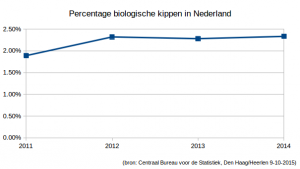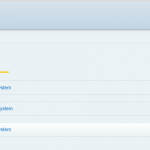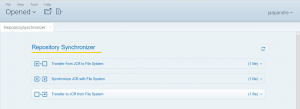Vandaag is het de dag van de duurzaamheid en de internationale dag van het ei (*). Het leek me leuk om deze twee te combineren. Een interessante vraag is dan: Hoeveel eieren worden er duurzaam geproduceerd en wat is de trend daarvan. Het vinden van data viel me erg tegen. Het CBS publiceert alleen over het aantal bedrijven en aantal dieren en maakt alleen onderscheid tussen totaal en biologisch. Ze publiceren dus niet apart over bijvoorbeeld vrije uitloop, scharrel- en kooieieren. Het productschap vee, vlees en eieren publiceerde wel een overzicht. Maar deze is opgeheven per 1 januari 2015, dus zijn hier ook geen recente cijfers te vinden. Ook veel andere ‘ei’-organisaties zijn moeilijk online te vinden of hebben geen data.
De beste gegevens die ik gevonden heb, zijn dus het aantal biologische leghennen als aandeel van alle leghennen voor de periode 2011-2014. In onderstaande figuur is te zien dat dit percentage iets meer dan 2% is. Er lijk 2012 een kleine stijging gerealiseerd te zijn. Als ik meer tijd kon besteden, had ik mogelijk ook informatie over vrij uitloop en scharreleieren kunnen vinden. We zouden dan een beter beeld hebben van de productie (en daarmee het gebruik) van duurzame eieren.
* ) De komende tijd zal ik vaker een post doen geïnspireerd op de ‘Dag van…..’. Bijna elke dag is het wel een bijzondere dag. Een mooi overzicht is te vinden op: http://www.fijnedagvan.nl/. Ik zal er een aantal kiezen om een data-gebaseerde post te schrijven. Daarbij zal ik wel steeds vanuit een vraag vertrekken.






